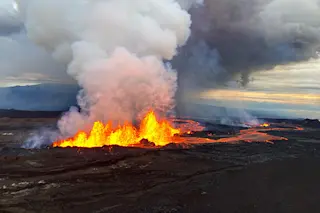Just a few days ago, our planet's largest active volcano stirred to life for the first time in nearly 40 years. Since then, the erupting fissures high atop Mauna Loa in Hawai'i have been propelling lava fountains as high as 13-story buildings, and driving rivers of molten rock as far as eight miles down the mountainside.
The natural spectacle, which began late on Nov. 27, has been captured in breathtaking photos and videos taken by experts from the U.S. Geological Survey, as well as by satellites orbiting high overhead. What follows is a sampling of this imagery.
The aerial view above shows erupting fountains supplying lava to a flow that's advancing north of the rift zone.
Here's a still photo captured during the same flight:
Lava flows on Mauna Loa's Northeast Rift Zone photographed from the air at about 9:30 a.m. on Nov. 28. The view is to the northwest. ...














